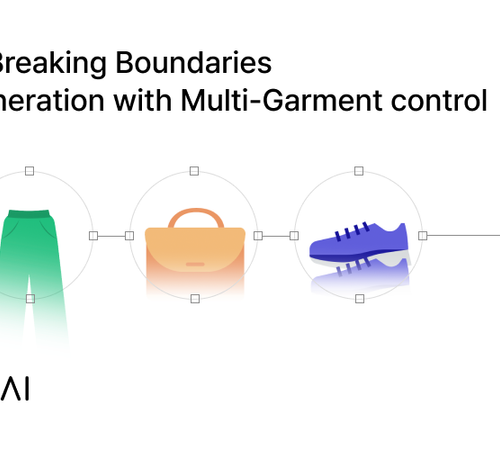Fashion Forward with Automation
It is difficult to picture where we exist in history. The present is ever moving, and our own thoughts, decisions, and actions make up the future. While deciding our place in societal evolution may be too overwhelming for the average person, historians and economists have put a lot of time into understanding just that. According to many experts, we are in the midst of the Fourth Industrial Revolution, the quiet revolution of automation.
The term Industrial Revolution is not used lightly. The true revolution will impact nearly every industry with The Economist predicting that 50% of all jobs will come to be improved by automation to support this conclusion. Being one of the world’s largest and most innovative industries, fashion is at the center stage of this shake-up. The pandemic has affected the Fashion Industry by shifting sales almost entirely online, disrupting the brick & mortar retail labor supply, therefore a serious effort is being made to redeem such losses.
Automation improves productivity as well as the quality of fashion products by minimizing human intervention and preventing manufacturing mistakes. It has already shown promise through its currently limited use in the industry. As technology develops so will the industry, predicted to change rapidly with new automated innovations. The generation to come will need understanding and knowledge of the latest methodology to continue such advancement.
Through reflection on current automation trends and directions, the following aims to display what such technology can/will bring to the Fashion Industry, ushering in a new period of economic success in the face of a very trying past two years.
Tag, You’re It: Automated Product Tagging
Catalog management is a dynamic process in which items are categorized in a specified way to provide high-quality data consistency across all sales channels. It also entails properly and efficiently improving, enhancing, and arranging product data. This is an inescapable component of the fashion industry. Fashion necessitates a plethora of items, all of which must be arranged in order for customers to be satisfied in their journey.
The consequences of bad catalog management can result in poor supply chain interactions which can throw an entire business into disarray and strain customer relationships. The threat of delayed product onboarding and go-to-market strategy is also a devastating consequence, inaccurate site search further disrupts the customer journey leading to frustration and often ruining potential sales. Upsetting customers requires an overwhelming need for consumer support to help balance out those issues, a large cost that struggling companies may not be able to finance.
The yearly cost of poor quality data in the US alone was $3.1 trillion in 2016 according to the Harvard Business Review. The majority of fashion businesses are unable to afford such oversights, and even those that can survive such losses are far better off minimizing these issues.
Of course, the reason these issues remain is due to the difficulty of fixing them. The major challenges of catalog management, such as the abundance of products that impact accuracy, the cost of hiring employees for tedious work, and the inability to create meta-data, are all leading factors in the failure for such serious issues to be fully resolved.
Thankfully, automated processes have been used as a solution for each of these concerns and can potentially provide the best way for businesses to navigate this e-commerce minefield.
SOLUTION: Automated Product Tagging
Automated product tagging can help brands, multi-brand retailers and e-commerce enterprise companies rely on the use of AI to minimize human effort and reduce error rates. Combined with customer ratings and reviews, these factors can take a product to the very top of search results which automatically gives an instant boost on the sales of the product. It decreases the time taken to tag catalogs, improving the accuracy of both the tags and search engine results on sites. More importantly, it can save up to 90% on operational costs. Accurate and SEO-ready tags, titles, and descriptions for products can boost product discoverability on Google. They enrich the meta-data of the catalog, boosting the quality of information available on each product.
Reap What You Sow: Automated Sewing
Apart from powering sewing machines with electricity, the industry has remained largely stagnant since the industrial revolution of the 1800s. There are several reasons for this seemingly impractical hold on development.
While machines can often accomplish tasks near impossible for humans to accomplish, there are limitations to their capabilities. Most machines work best in competitive tasks that require well-understood variables. Sewing is unfortunately as varied as it is competitive which can cause trouble for full automation.
These variations result from the inconsistencies and varieties of the fabric itself, the placement of zippers and alignment of buttonholes, and other aspects of human dexterity and/or intuition incapable of most machines.
However, the need for clothing has come to outmatch the human workforce with Covid-19 accelerating this process. The pandemic has increased the demand for low-cost clothing with a rise in loungewear, sweatpants, and T-shirts New York Times reported that while clothing sales fell by 79% in the U.S. in April, purchases of sweatpants were up by 80% during the pandemic.
The determining factor for sales relies on the speed of manufacturing, which has led numerous companies to outsource to foreign countries where cheaper labor is available.
SOLUTION: Automated Sewing
Automation for sewing has been difficult but not impossible to develop. As technology advances, so do the capabilities of machines, allowing them to take on the until now too complex work of sewing. The automated process will increase production and at the same time significantly drop production costs. Every T-shirt produced by an automated sewing machine is expected to cost just $0.33 This cost is significantly lower than any cheap labor market around the world where prices are constantly on the rise. Therefore, an automated sewing system will make it possible for companies, not only to save money but also to move production closer to their headquarters.
Copyright and Wrong: Automated Design
Fashion designers have far more responsibilities than those shown on TV shows.
Some of their many tasks are as tedious as they are important. Fabric testing often falls upon the fashion designer along with all the correspondence to secure permission to pursue their creative ideas. Sewing the original models of planned garments is a time-consuming process that may require numerous versions before final approval. Visiting textile showrooms is another task often on a designer’s already busy schedule, crowded with meetings, conferences, and fashion shows. The creative spark that engages audiences and forms the latest trends remains undeniably human. However, the many obstacles that come between designers and this prized role, can surely benefit from automated help.
Even aspects of fleshing out creative work, such as the abundant preliminary sketches, miniatures, and test sheets have room for improvement beyond the human hand. The time spent accomplishing relatively menial tasks or traveling for meetings, tours, and shows can be spent on more uniquely productive aspects of their work – those impossible for a machine.
Along with all of these responsibilities are the actual designing aspects which face their own issues. Fashion designers can find themselves copying each other by accident leading to lawsuits and otherwise damaging brand reputations. These oversights can cost companies much of their revenue. While it may be impossible to eliminate all issues and tedious responsibilities for designers, many can be regulated through automation.
SOLUTION: Automated Design Registration Software
The use of automated design registration has greatly improved problems, guaranteeing that concepts are unique and those imitations are identified. Without advanced designs and inventive tactics, the current fashion business would be unsustainable, thus this is an important function to play in the sector’s success. Shortcut virtual conference software built to boost business during the epidemic has increased designer communication and research. Digitized drawings make dissemination, accuracy, and replication much easier. In general, automation has shown considerable promise in making the design more efficient for businesses and creatives.
Forging the Fourth Industrial Revolution
Automation can be seen as the shining light for a brighter future. Even more innovative entrepreneurs, engineers, and fashion experts will have the opportunity to help carry forward the future of data-driven and automated fashion. The advancement of technology in inventory management, production and design will open the door to greater innovations and prevent time from being wasted on tedious yet necessary tasks. Education is undeniably important to keep up with the pace of change that will arise from automation adoption.
Educational initiatives must move even faster than the industry to prepare the next generations of fashion industry employees for an automated future. The setbacks of the pandemic will likely push such advances even further than previous generations to balance out the lingering economic effects, bringing welcomed changes to further propel our societies to the Fourth Industrial Revolution.
Partnerships with higher education will prove even more valuable, as they pave the road for the next generation. Businesses will need employees educated to handle all of these different automotive technologies.to ensure an easy transition into the fashion industry of the future, a future less plagued with the tedious and easily disrupted tasks of the present.
Jaeyoung Jun is the Founder and CEO of OMNIOUS.AI. As an award-winning industry researcher, Jaeyoung Jun’s credentials include conducting R&D for major government agencies and technology companies worldwide. Jun has been leading the digital revolution of the fashion industry since 2015. While working towards his Ph.D, Jun founded OMNIOUS.AI after eeing the potential applications of deep learning technology in the fashion industry. Jun had the vision to commercialize technologies that can read, quantify, and locate specific fashion data and trends directly from images. Jun’s contributions to online fashion businesses, e-commerce companies, and retailers were awarded in 2020 when he was selected as the grand prize winner in the startup sector at the 30th Korea Textile and Fashion Awards.
(source : SmallBusinessCURRENTS)






